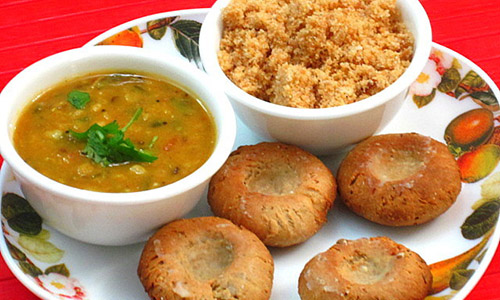
Rajasthani food is a good example of royal cuisine. Cooked in pure ghee, it is famous for it's mouth- watering aroma. Lifestyle of its inhabitants and the scarcity of ingredients in the desert region, has resulted in food that could last for several days and could be eaten without heating as the inhabitants were either on war or were nomads. Scarcity of water and lack of fresh green vegetables also had their effect on Rajasthani kitchen. The use of mango powder, a suitable substitute for tomatoes, and asafetida, to enhance the taste in the absence of garlic and onions are also the result of the scarcity of vegetables in the desert land.
Dried lentils and beans from indigenous plants like sangri, ker etc. are staples of the Rajasthani diet, as wheat and rice do not grow very well in the desert land of Rajasthan. Gram flour and powdered lentils are used to make delicacies. Baja and corn are used all over the state for making rotis and other varieties of bread. Even today milk, buttermilk and clarified butter are used as alternatives for water. Generally, Rajasthani curries are made out of milk products as buttermilk, etc. Appropriate use of digestives, especially asafetida, black rock salt, ginger and ajwain balance the use of milk and milk products.
Pink city and food festivals have almost become synonymous. Since last few years the city has been witnessing an increase in the number of food festivals. People here at Jaipur have developed a special appetite and often impart a party spirit to these events providing a rare chance to relish the delicacies from around the world. Apart from the spicy delicacies, each of the regions of Rajasthan is famous for its popular sweet. Ladoos of Jaisalmer, mawa kachori of Jodhpur, malpuas of Pushkar, dil jani of Udaipur, mishri mawa and ghevar of Jaipur, sohan halwa of Ajmer, mawa of Alwar, and rasgullas of Bikaner, are just a few of them.